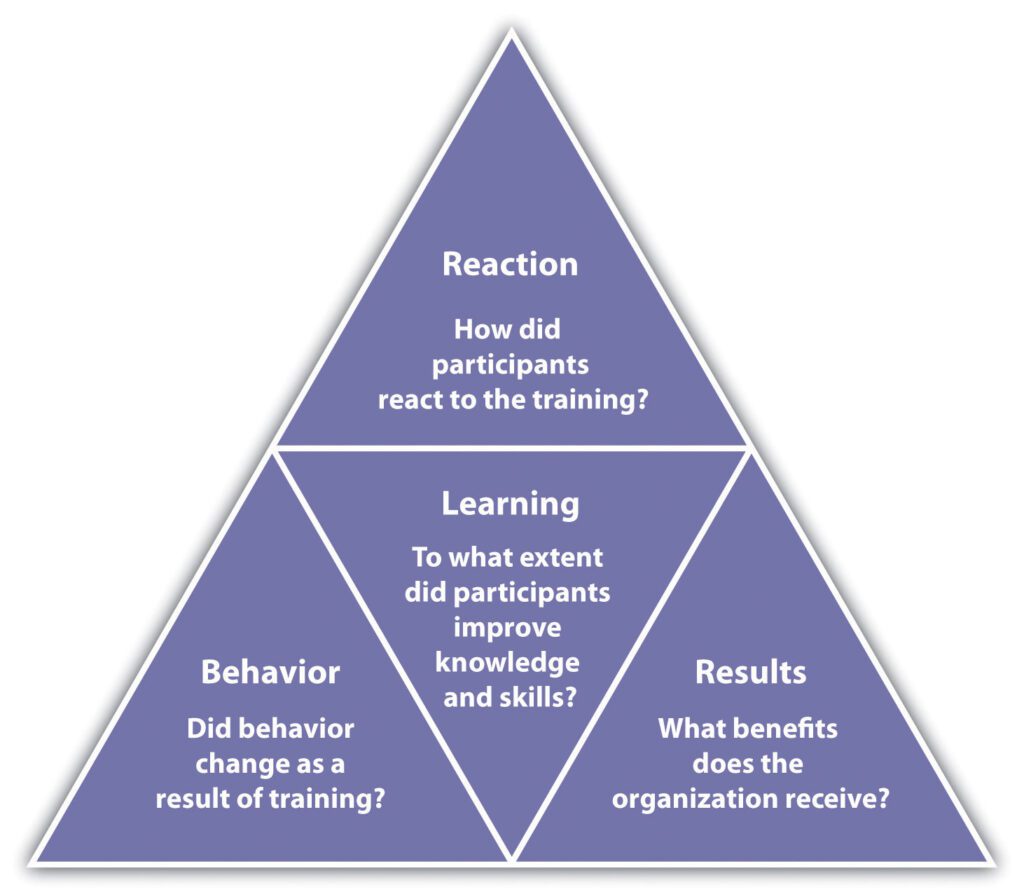Kirk Patrick Model
The Kirk Patrick Model, also referred to as the Kirk Patrick Four-Level Evaluation Model, is a well-liked paradigm for evaluating the efficacy of training initiatives. The model was created by Donald Kirkpatrick in the 1950s and has since been widely embraced by professionals in instructional designing all over the globe.
History
Donald Kirkpatrick made the Kirk Patrick Model in the last part of the 1950s, and it has since been refined and developed by his child, James Kirk Patrick, and other preparation and improvement analysts. The model comprises of four degrees of evaluation, every one of which expands on the past level, and it fills in as a guide for surveying the viability of preparing programs.
We will go over each level of the Kirk Patrick Model and how evaluating the viability of preparing programs in this article can be utilized. We’ll likewise give you a few pointers on the best way to apply the Kirkpatrick Model in your organization.
The four levels
There are four levels of evaluation in the Kirk Patrick Model, each of which expands on the one before it. Following are the levels:

Level 1: Reaction – Participants’ responses to the training curriculum are evaluated at this level. It emphasizes on how enjoyable, pertinent, and practical the training was for the participants.
Level 2: Learning – This level evaluates how much participant learning has occurred as a consequence of the training course.
Level 3: Behavior – This level evaluates how well participants have integrated the training program’s lessons into their daily job.
Level 4: Results – This level evaluates how the training program affected corporate performance, including boosted output, enhanced quality, and decreased expenses.
Let’s take a dipper look into all of these four levels.
Level 1: Reaction
This is the most basic and primary level of the Kirk Patrick Model that centers on the students’ responses to the preparation program. This level assesses how students feel about the preparation program and whether they find it intriguing, relevant, and accommodating. This level is also known as the “grin sheet” level because it frequently entails gathering input via overviews or surveys.

Trainers can assess this level by asking learners to provide input on the training program via surveys or questionnaires. Questions about the learners’ perceptions of the training curriculum, such as:
- Did you find the training program intriguing and engaging?
- Was the training curriculum applicable to your position?
- Did the training session teach you anything new?
- Do you believe the training program will benefit your job?
Trainers can assess the effectiveness of the training program and make required improvements by collecting feedback from learners. This degree of evaluation is critical because it informs trainers about whether learners found the training program useful and engaging.
Level 2: Learning
The Kirkpatrick Model’s subsequent level spotlights on the students’ information and abilities gained from the preparation program. This level surveys whether students have procured the information and abilities expected to effectively execute their positions.

Coaches can utilize pre-and present tests on evaluate students’ information and abilities at this stage. The pre-test ought to be given before the preparation program, and the post-test ought to be given after the preparation program to evaluate the students’ information and capacities.
Mentors can decide if students have acquired the essential information and abilities to execute their positions effectively by assessing this level. In the event that students have not procured the essential information and abilities, mentors can adjust the preparation program to ensure students secure the vital information and abilities.
Level 3: Behavior
The third level of the Kirk Patrick Model focuses on the behavioral changes that occur as a consequence of the training program. This level assesses whether learners are applying their training program information and skills in their jobs.
Trainers can assess this level by observing learners on the job or conducting follow-up surveys to determine whether learners are applying the information and skills acquired through the training program. The inquiries should center on how the learners’ behaviors have changed, such as:

- Have you put your training program information and skills to use on the job?
- How has the training program improved your work performance?
Trainers can determine whether learners are applying the information and skills acquired from the training program to their jobs by evaluating this level of Kirk Patrick Model. Trainers can provide extra support to help learners apply their knowledge and skills to their jobs if they are not applying their knowledge and skills.
Level 4: Results
The fourth level of the Kirk Patrick Model concentrates on the outcomes of the planning program. This level assesses the effect of the readiness program on the affiliation’s targets and objectives.

Trainer can evaluate this level by gathering data on the effect of the planning program on the affiliation’s targets and objectives, such as increased proficiency, increased client devotion, and cost hold reserves. Trainers can also collect data in a variety of methods, including outlines, gatherings, performance metrics, and execution measurement.
By assessing this level of Kirk Patrick Model, coaches can decide the general effect of the preparation program on the objectives and goals of the association. This level is significant in light of the fact that it gives proof of the sufficiency of the readiness program and approves the forecasts of the planning program.
Expert Tips for Using the Kirk Patrick Model
Here are a few supportive clues for executing the Kirkpatrick Model in your association:

- Characterize clear and quantifiable preparation objectives for each level of the Kirkpatrick Model.
- At each level, utilize a scope of assessment procedures like reviews, tests, perceptions, and meetings.
- Gather information from different sources, including students, managers, and clients, to acquire a total image of the preparation program’s impact.
- Utilize the gathered information to find regions for development in the preparation program and roll out the important improvements.
- Impart the assessment discoveries to hierarchical partners to show the viability of the preparation program and legitimize the interest in the preparation program.
Comparison between ADDIE and Kirk Patrick Model
There are a few equals and contrasts between the ADDIE model and the Kirkpatrick Model.
Similarities:
- The two models give an organized procedure to preparing program creation and assessment.
- The two models are repetitive, and that implies the strategy can be rehashed as the need might arise.
- The two models are worried about achieving the preparation program’s goals.
Differences:
- The ADDIE model is a straight and successive model, while the Kirkpatrick Model is a four-level structure for evaluation.
- The ADDIE model spotlights on preparing program arranging and advancement, while the Kirkpatrick Model spotlights on preparing program assessment.
- The ADDIE model is mostly worried about the course of educational plan, while the Kirkpatrick Model is worried about the effect of the preparation program on students and the association.
Conclusion
The Kirk Patrick Model gives an exact and far reaching strategy for reviewing program feasibility. Tutors can assess the effect of the readiness program on understudies and the organization at each level of the model. This model is key for guaranteeing that readiness programs are compelling and add to the association’s targets and objectives. By carrying out the Kirk Patrick Model, you can ensure that your association’s arrangement programs are huge, significant, and critical.
Free e-book
Click on the below download button to get the free e-book written for the complete beginners to understand the Kirk Patrick model well enough to execute on your own.

![The Power of Storytelling in Corporate Training: Igniting Success and Inspiring Growth [2023]](https://trainercentric.com/wp-content/uploads/2023/06/storytelling-1024x576.jpg)

